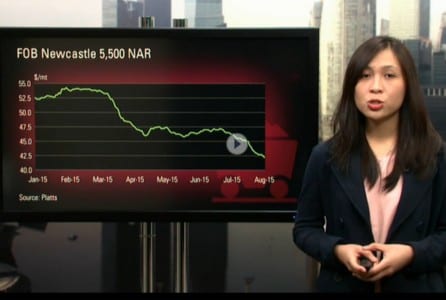Thermal coal prices have continued to decline, hitting new lows in August, with the Newcastle 5,500kcal thermal export coal benchmark down 20 percent year to date at US$42/t.
 As Lachlan Shaw, chief commodity strategist at UBS, points out in a just-published note, global traded thermal coal demand has declined to an annualized 900 million tons per annum in 2015 after peaking at an annualized 1,000 in. UBS sees global seaborne coal demand bottoming out in 2016, and then gradually recovering at a rate of 1 to 2 percent annually to 2019—growth driven by the assumption that Indian and Chinese thermal imports will gradually rise in the medium term.
As Lachlan Shaw, chief commodity strategist at UBS, points out in a just-published note, global traded thermal coal demand has declined to an annualized 900 million tons per annum in 2015 after peaking at an annualized 1,000 in. UBS sees global seaborne coal demand bottoming out in 2016, and then gradually recovering at a rate of 1 to 2 percent annually to 2019—growth driven by the assumption that Indian and Chinese thermal imports will gradually rise in the medium term.
Among the key export countries, Indonesia has seen the largest market share loss in the past 18 months, with exports down more than 50Mtpa annualized, versus a peak of 400-450Mtpa in 2013. Australian thermal exports are down 15Mtpa from their peak while Russia is down 10Mtpa.
UBS has China possibly becoming an opportunistic thermal coal exporter, but says it will remain a net importer of thermal coal. UBS assumes China returns to marginal growth over 2017-2019.
UBS estimates, too, that Indian thermal coal imports may have peaked at 200Mt annualized, and have since declined to 160Mtpa annualized. UBS assumes India returns to marginal growth over 2017-2019.
The global cost curve for thermal coal has dropped 25-30 percent in U.S.-dollar terms in the past three to four years according to UBS’ estimate, but coal is less competitive to oil and gas in terms of price moves over 2014-15.
UBS shows two different scenarios for Japanese coal demand: one from the Japanese government via its Ministry of Economy Trade and Industry (METI) and another from Bloomberg New Energy Finance (BNEF). METI has electricity demand in Japan flat through to 2030, whereas BNEF has it declining by 0.8% CAGR (here at IEEFA, we think energy efficiency is the No. 1 driver of declining demand and we see a decline of greater than 1 percent annually). Both the METI and BNEF forecasts factor in a nuclear restart. Gas and oil demand for electricity generation both decline, while solar and wind both rise five to tenfold in these forecasts. The conclusion from both scenarios is that Japanese coal demand peaked in 2013 and will decline 1 to 3 percent annually hereafter. Japan is Australia’s No. 1 export market for coal.
UBS also sees thermal coal prices recovering to US$88/t by 2019 in nominal terms, driven by a gradual rise in import demand from China and India.
This forecast is one of the highest longer-term among the major financial houses, and we think it is very debatable.
We see growth in energy efficiency, grid efficiency, and domestic coal production, and we see a rising reliance on wind, solar, gas and hydro. We’ll be updating our forecasts with the new data from August 2015 later this week.
Tim Buckley is IEEFA’s director of energy finance studies, Australasia.






